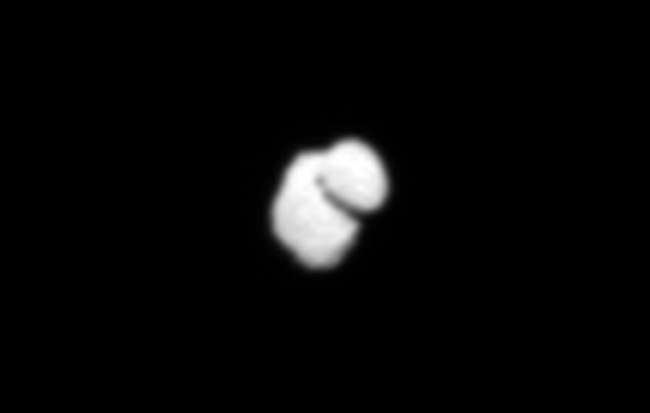
The comet being chased down by a European probe looks a bit like a child's bath toy, new images from the spacecraft reveal.
The European Space Agency's Rosetta spacecraft has gotten its best look yet at Comet 67P/Churyumov-Gerasimenko, with which it will rendezvous early next month. And the results are surprising, researchers said.
"This is unlike any other comet we have ever seen before," Carsten Güttler, of the Max Planck Institute for Solar System Research (MPS) in Germany, project manager for Rosetta's scientific imaging system, said in a statement. "The images faintly remind me of a rubber ducky with a body and a head."

The new photos — taken on Monday (July 14), when Rosetta was about 7,500 miles (12,000 kilometers) from 67P — show that the comet's nucleus is made up of two distinct parts. Researchers don't yet know the origin of this strange shape; further study over the next few months could reveal if 67P's "body" and "head" were once two separate objects, they said.
Rosetta launched in March 2004 on a long and circuitous journey to Comet 67P/Churyumov-Gerasimenko, whose nucleus is about 2.5 miles (4 km) wide. The spacecraft woke up this past January from a record 957-day hibernation and is scheduled to arrive at 67P next month. If all goes according to plan, Rosetta will then become the first probe ever to orbit a comet.
Rosetta will stay with 67P as the object cruises through the inner solar system, using its 21 scientific instruments to document how the comet changes as it approaches the sun. In November, Rosetta will also drop a lander called Philae onto the comet. Philae will collect samples and take the first-ever photos from the surface of a comet, European Space Agency officials said.
The total cost of the Rosetta mission is 1.3 billion euros ($1.77 billion at current exchange rates). Operations are scheduled to end in December 2015.
Get the Space.com Newsletter
Breaking space news, the latest updates on rocket launches, skywatching events and more!
Follow Mike Wall on Twitter @michaeldwall and Google+. Follow us @Spacedotcom, Facebook or Google+. Originally published on Space.com.
Join our Space Forums to keep talking space on the latest missions, night sky and more! And if you have a news tip, correction or comment, let us know at: community@space.com.

Michael Wall is a Senior Space Writer with Space.com and joined the team in 2010. He primarily covers exoplanets, spaceflight and military space, but has been known to dabble in the space art beat. His book about the search for alien life, "Out There," was published on Nov. 13, 2018. Before becoming a science writer, Michael worked as a herpetologist and wildlife biologist. He has a Ph.D. in evolutionary biology from the University of Sydney, Australia, a bachelor's degree from the University of Arizona, and a graduate certificate in science writing from the University of California, Santa Cruz. To find out what his latest project is, you can follow Michael on Twitter.









